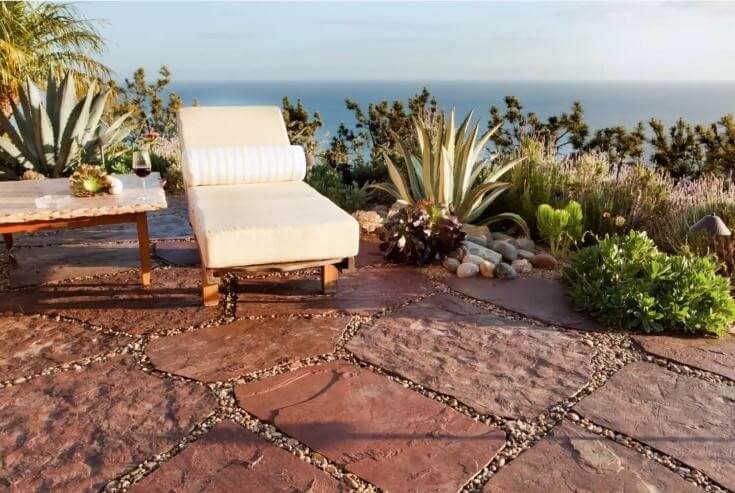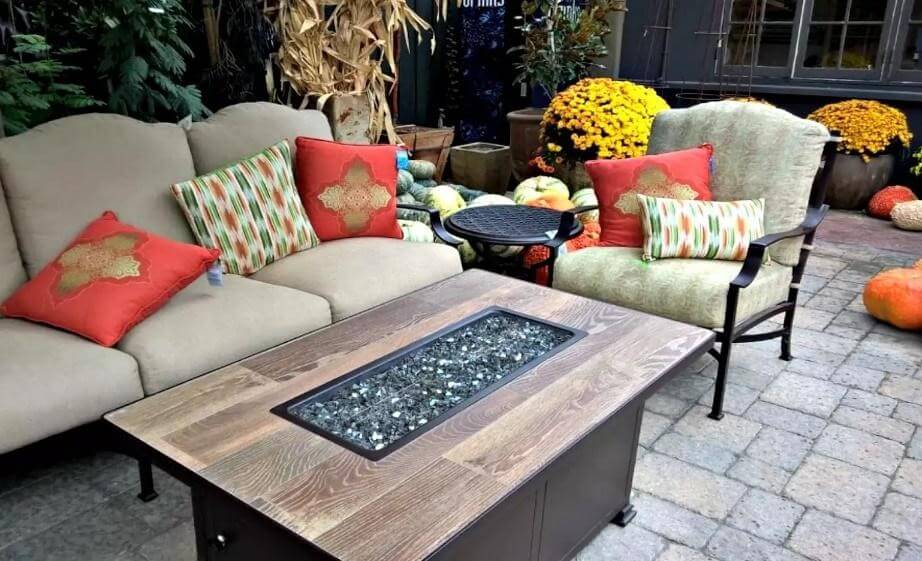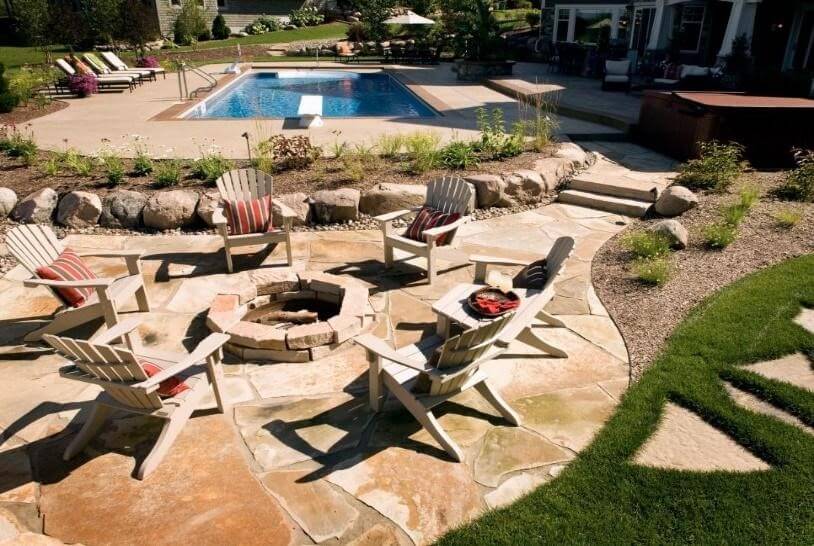The backdoor aesthetics of the home is a real patchwork. Remodeling it to add value to the home or to just create a cozy nook where everyone could gather around anytime are the primary reasons why paver patios have become a trend in hardscaping and landscaping.
The good news is paver patios need not be too expensive as some designs can be done DIY or with minimal labor cost. “In order to make your back door look elegant, it is strongly recommended to use the best furniture sprayer to paint your old wooden patio furniture,” says Jennifer Marie, founder of Holapaints. If you are wondering what paver patio designs you could build inexpensively, here are some paver patio ideas on a budget.

Related: Driveway ideas on a budget
30 paver patio ideas on a budget
When you are on a tight budget, the go-to choice is always gravel but you do not need to resort to this patio material if you have budget patio ideas to choose from. Here are thirty paver patio ideas on a budget that you could draw inspiration from.
1. Gridded paver patio

The simplicity of neutral-toned pavers contrasting on a grid and in a backdrop of the lush landscape is a timeless and inexpensive idea to consider. Round seating, an outdoor umbrella, and flagstone grids are classy but flashy. There is nothing neater than gridded paver patios.
2. Paver patio with an open view


If you have an elevated property that comes with a view of an open sea, tracks of fields, or a vineyard, opting for an open view paver patio can be one of the best choices.
Make it rough and rustic by installing an unpolished, irregular shaped flagstone with pea gravel in between. Complement it with a fitting landscape and build on the seating and lightwork for a beautiful night view.
3. Modern neutrals

Creating a minimalist/modern style suburban patio banks on the combination of neutral colored details. You can start if of with dark gray or charcoal colored pavers on a tropical backdrop.
To add a modern touch, give a twist to the details like adding a mid-century modern couch instead of wooden patio seats. Putting in a mini countertop firepit is also a fine detail for a centerpiece.
4. Zen style


This design is timeless because it is anchored on balanced landscaping and the mixing of various elements like wood, stone, and concrete. To spruce up your patio, you can install a hardwood patio deck with bluestone pavers in between to serve as a walkway.
You can extend the paver walkway up to the main house or connecting to the garden by adding turfgrass to boarder them. Add a plush pebble garden and put in the succulents and other tropical plants that will complete the patio’s Zen look.
5. Brick block paver patio

If you want a low-key surface that will not overpower the landscape with a paver material other than flagstone or cobblestone, go for blocked bricks. This creates a smooth, even surface. Instead of the traditional red bricks, using natural stone color, bluestone or the gray ones would be better fitting.
With these colors, you can install flashy seating and colorful throw pillows to go with them. Adding in a firepit in the middle and equally colorful landscape would seal the deal.
6. Small corner patio

If you are working with a cramped up backdoor space but still want to squeeze in a patio, you can set up a corner patio where a firepit and two-three seats are waiting at the end of a garden walkway. Positioning it across a compact lawn makes the suburban home more upscale.
Going with a touch of dark-colored flagstone or cobblestone for the paver floor and matching it with the firepit is a sleek detail.
Related: Cheap fire pit ideas for your backyard
7. Private paver patio

If you want to build a secluded, bridge to Terabithia feel, putting up poles where climber plants could grow and fence the entire space must be the first step. You can set up a wall firepit adorned with another set of climbers on the side.
Throw in the wooden seats and add detachable cushions for more flexible convening especially when the weather is erratic. Use ashlar bluestone pavers. Thin turfgrass or pea gravel in between are also good accents in between the pavers.
Related: 19+ Types Of Gravel For Driveways and Landscaping
8. Pergolas and pavers mix

If you are eyeing more open backdoor space, go for the classic pergola and pavers combination. You can use sealed irregular shaped bluestone blocked pavers. Build a firepit centerpiece made of rough natural stones and surround it with rattan or wood benches.
Construct slatted pergolas in contrast to slatted boards where climbers could grow as natural fences. Install the lightwork in the pergola posts to have a dreamy paver patio at night.
9. Circular paver patios

Stone houses and large lawns can be enhanced more by circular corner paver patios. You can use blocked bricks of blue and charcoal gray color.
Circling in could be the firepit centerpiece made of unpatched cobblestone. It is that detail that will give it a rustic vibe. Put in some wooden benches, an outdoor grill on one side and it is done.
10. Curved walls


The box-type patio is what we can say as the default design but having some curved walls add dynamics to the entire design.
The curved walls could be dual purpose as it can be used as added seating or the curved walls could be the secluded stone bench altogether and add some cushions on it.
But make sure that all the other spaces are maximized too. You can add another seat set on one side, a fire pit in the center, and a grill on the other side. Use neutral-colored stone pavers, bluestone pavers or some herringbone/chevron-patterned block bricks.
11. Poolside patio paver


If you are working out with a patio that extends to a pool, might as well floor out the poolside with stone pavers too. Instead of just using turf grass and poolside seats, stone pavers will make the poolside neater, matching it with the firepit and the patio.
You can use ashlar stone pavers, bricks, or bluestone/flagstone pavers with pea gravel or thin grass in between. You may also explore blocked bricks as an alternative.
12. Backyard patio grill

To maximize the back patio that you are building, you can infuse a dirty kitchen, bar, fire pit, and barbeque grill in one space. Who would not love to have a brick firepit on one side and a brick oven mounted on the stone wall on the other?
You can also have a granite counter in the middle with a rustic brick or flagstone floor surrounding the space. Throw out those wood or rattan seats, put in soft lightwork around it and you are good to go.
Having a pergola to surround it on top with sealed flagstones of orange, gray, and blue colors is also a good choice.

13. Natural stone paver patios

If you want to have a post-modern patio with various stone elements in one entire backyard, you must bank on a natural stone paver patio. You can set-up the poolside with square, unsealed natural stones with pea gravel or grass in between.
The firepit on the other side can be installed with sealed, irregular-shaped natural stones, wooden benches, and a rough cobblestone firepit in the middle. The two can be separated by a patch of landscape.
14. Cottage gardens and rough stone pavers

If you want to achieve a cottage garden feel, complete with the stone and wood ensemble of the house, you should go with thick, irregular-shaped flagstones or cobblestones.
Give enough space in between the stones for grass to grow. Make an effort to develop the landscape by choosing the best perennials and low-growing flowering shrubs that will complete the cottage garden feel.

15. Edged stone pavers

If you want to notch up your blocked pavers or blocked brick back patio, you can add accent edges. You can use fine, colored gravel, cement, and smaller bricks. You can even add other elements like vinyl edging or even metal. Having edges like this is good if you want to resist weed growth.
Beyond this, add the usual patio elements like wooden benches, cobblestone and granite countertop, a small bar, and even a fire pit in the middle if you want to.
16. Brick and ashlar

Ashlar and brick are not ordinary combinations for a patio. Most often than not, the choice is either brick or ashlar. But if you want a Hispanic vibe to your patio, you can use blocked ashlar stone pavers for the floor and build a traditional orange brick for either a fountain or fire pit in the middle.
Distribute seat sets in all parts of the patio. Having an outdoor dining area that connects to the brick firepit and ashlar floor is also a good idea.
17. Firepit, pool, and bar


You can connect all these three patio details using one clean ensemble. Darker colored cobblestones or flagstones must be used if you are living in a windy and rainy location or anything that matches your home’s aesthetics.
Having curved walls to add dynamics to the design is also fine detail to an add-in. Work on the landscaping and add lightwork in the bar and poolside. Put a fire pit near the pool or make a corner firepit on one side.
18. Terraced patio pavers

Whether you are working with a large patio or a compact one, it would not hurt to go for a terraced design. Aside from adding new angles to the home, the various elevations give you time to appreciate the landscaping of the home.
Adding water features such as modern design fountains along bluestone or ashlar stone pavers that will lead to the firepit place above is a good touch. Putting in garden lamps and natural plant fences to seclude the elevated firepit is also a beautiful addition.
19. Naturally rustic

Nothing beats the vibe of a back patio whose pavers make it feel like they have been installed there since forever. If you want to have a look like this, use grayish blue and orange-brown tones for your flagstone pavers.
Install them in a blocked design, fence the area with slatted boards and put in some outdoor grill, oven, and wooden benches.
20. Minimalist


If you want to achieve a clean, minimalist look, go for the inexpensive gravel and cobblestone combination. Instead of arranging different elements and fixtures that should go in like bars, benches, firepits, and light work, you can just make a minimalist walkway out of your patio.
You can pour in gravel in the whole area where the fire pit and seating should be located and install stone paver walkways with one path extending to the backdoor and the other extending to either the pool or the garden. You can also make a long pathway going to the garden with a patch of turfgrass accentuating it.
21. Firepit centerpiece

This is like an extension of the curved patio design. The only difference is that in here, you are creating a blocked paver pathway that leads to the firepit area like the patio’s focal point. As its centerpiece, it is enclosed in circular paver walls and a blocked paver floor.
Both the paver walkway and the firepit area’s floor could be the same in color but two contrasts will be more beautiful. The circular, walled firepit area creates an intimate vibe where family and friends could gather.
22. Small cozy nook

If your home is surrounded by several outbuildings like tool sheds, a home office, or a garden gazebo, you can actually have different back patio areas for each.
This means that you will build small cozy nooks for each of them using sealed stone pavers and small seat sets. To connect them in one whole back lawn, use turfgrass and stone paver walkways resembling rays.
23. Sunken seating


It is just a small tweak in the default box set-up but it makes everything a little dramatic especially for a back patio regardless if the space is large or compact.
Aside from the added angle, a sunken seating also adds privacy to the patio, giving low shrubs an added function of being natural walls.
The sunken seating can be curved or box, add some cushions on top and you have an additional set to accommodate a party of people. Use charcoal gray blocked stone pavers for the floor. If you want to go rustic, you can add pea gravel in between the pavers. Adding a firepit as a centerpiece must be the last touch.
Paver patio ideas on a budget – FAQs
What is the cheapest patio paver?
Gravel is the cheapest patio paver material out there costing $6-10 per square foot and can be done DIY. But when it comes to the cheapest patio paver, it would be brick pavers or technically called thin concrete pavers.
They cost from $2.50-5 per square foot. Runner-ups for the cheapest patio paver costing from $3-7 per square foot would be tumbled concrete brick, half bricks, and interlocking concrete.
Natural stones such as flagstones, bluestones, granite, and ashlar are the most expensive ones ranging from $7-16 per square foot.
Is a paver patio a good investment?
Yes, and for two reasons. First, hardscaping the home with paver patios make the ambiance more inviting. It adds a space for convening which is good for people with regular soirees or large homes with several family members.
Second, patio pavers are one of those landscaping and hardscaping projects that will add value to your home, real estate-wise. With a good design and when installed properly, you will get a sure return on investment with this one.
How much value does a paver patio add?
According to the National Association of Realtors (NAR) and National Association of Landscape Professionals (NALP), a paver patio that costs $7200 at a 18x20square foot dimension gives an added value of up to 69%.
Is a paver patio cheaper than concrete?
Well, the upfront cost of a paver patio is more expensive than concrete. Labor costs on installation as well as the cost of the material itself are twice the cost of poured or stamped concrete. However, with the durability and added value of paver patios to the home, you get to save more money in the long run.
What lasts longer concrete or pavers?
Poured concrete lasts to a maximum of 25 years while patio pavers could last up to 50 years. While this is at an average, certain considerations such as quality of installation, maintenance, and climate must be looked out for.
How long do paver patios last?
When installed and maintained well, paver patios have an average lifespan of 25-50 years.
Conclusion
Paver patios are commendable for their durability, longevity, and stunning aesthetics. You could be simple and rustic with gravel and complementing landscape or add sleek pieces like a firepit, seating, and light work to complete the whole ensemble. Truth be told, you will never run out of ideas when it comes to backdoor designs.
All that you need to make it is an eye for creativity, time to do it DIY, and observation of what details will top off your design beautifully. These are what the listed patio paver ideas on a budget here are all about and we hope that they sparked a drizzle of inspiration for your future patio paver project.

